Want to improve your marketing strategies without spending a dime? These 10 free marketing analytics tools can help you track performance, analyze user behavior, and optimize campaigns effectively. From website analytics to SEO tools, here's everything you need to know:
- Google Analytics 4 (GA4): Track website and app user behavior with AI-driven insights.
- Matomo: A privacy-focused alternative for GDPR-compliant analytics.
- Looker Studio: Create custom dashboards and visualize data from multiple sources.
- Coupler.io: Automate data integration across platforms for seamless reporting.
- Microsoft Clarity: Understand user behavior with heatmaps and session recordings.
- Google Search Console: Monitor search performance and fix technical SEO issues.
- Mixpanel: Dive deep into user engagement and track conversion paths.
- Whatagraph: Combine data from multiple platforms into simple, automated reports.
- Metrics Watch: Get key analytics delivered directly to your inbox.
- Ahrefs Free Tools: Boost your SEO with keyword research, backlink tracking, and site audits.
These tools are designed to simplify marketing analytics, save time, and provide actionable insights - all for free. Whether you need to track user behavior, automate reports, or optimize your SEO, there's a tool here to meet your needs.
| Tool | Best For | Key Features |
|---|---|---|
| Google Analytics 4 | Website & app tracking | Real-time data, AI insights |
| Matomo | Privacy-focused analytics | Self-hosted, GDPR compliance |
| Looker Studio | Data visualization | Custom dashboards, real-time updates |
| Coupler.io | Data integration | Automated data flows |
| Microsoft Clarity | User behavior insights | Heatmaps, session recordings |
| Google Search Console | Search performance | Keyword rankings, technical fixes |
| Mixpanel | User engagement analysis | Funnel tracking, retention insights |
| Whatagraph | Reporting across platforms | Automated, cross-platform reports |
| Metrics Watch | Email-based reporting | Direct email delivery, custom metrics |
| Ahrefs Free Tools | SEO optimization | Keyword research, backlink tracking |
Start with the tools that align with your goals, whether it's improving search rankings, tracking user behavior, or streamlining your reporting process. These free tools provide the foundation for smarter, data-driven marketing decisions.
Related video from YouTube
1. Google Analytics 4: Track Website and User Behavior

Google Analytics 4 (GA4) is a powerful free tool for tracking website activity and understanding user behavior. Designed with privacy in mind, it also incorporates advanced machine learning to help marketers stay ahead.
GA4 provides real-time data on metrics like page views and user engagement, while also mapping out user journeys across websites and apps. With its integration with Google Tag Manager, you can set up event tracking and reports without needing to touch code. Plus, its AI features highlight trends and offer predictions, such as churn probability or the likelihood of a purchase, giving marketers a chance to act before issues arise.
The platform seamlessly integrates with Google Ads and Looker Studio, creating a cohesive system. This allows you to combine ad performance data with user behavior insights, making it easier to fine-tune campaigns based on the entire customer journey. It also helps pinpoint which channels are driving the best results.
GA4 also includes advanced segmentation tools. These allow you to analyze user groups based on behavior, demographics, or custom parameters, making it easier to tailor content to specific audiences.
| Key Feature | What It Does |
|---|---|
| Real-time Reports | Keep tabs on live user activity and campaign performance. |
| Custom Dashboards | Create views tailored to your most important metrics. |
| Event Tracking | Monitor user actions like clicks or form submissions. |
| Automated Insights | Receive AI-driven tips to boost performance. |
While GA4 is a standout for tracking and insights, tools like Matomo offer alternatives for marketers with a stronger focus on privacy.
2. Matomo: Privacy-Focused Analytics
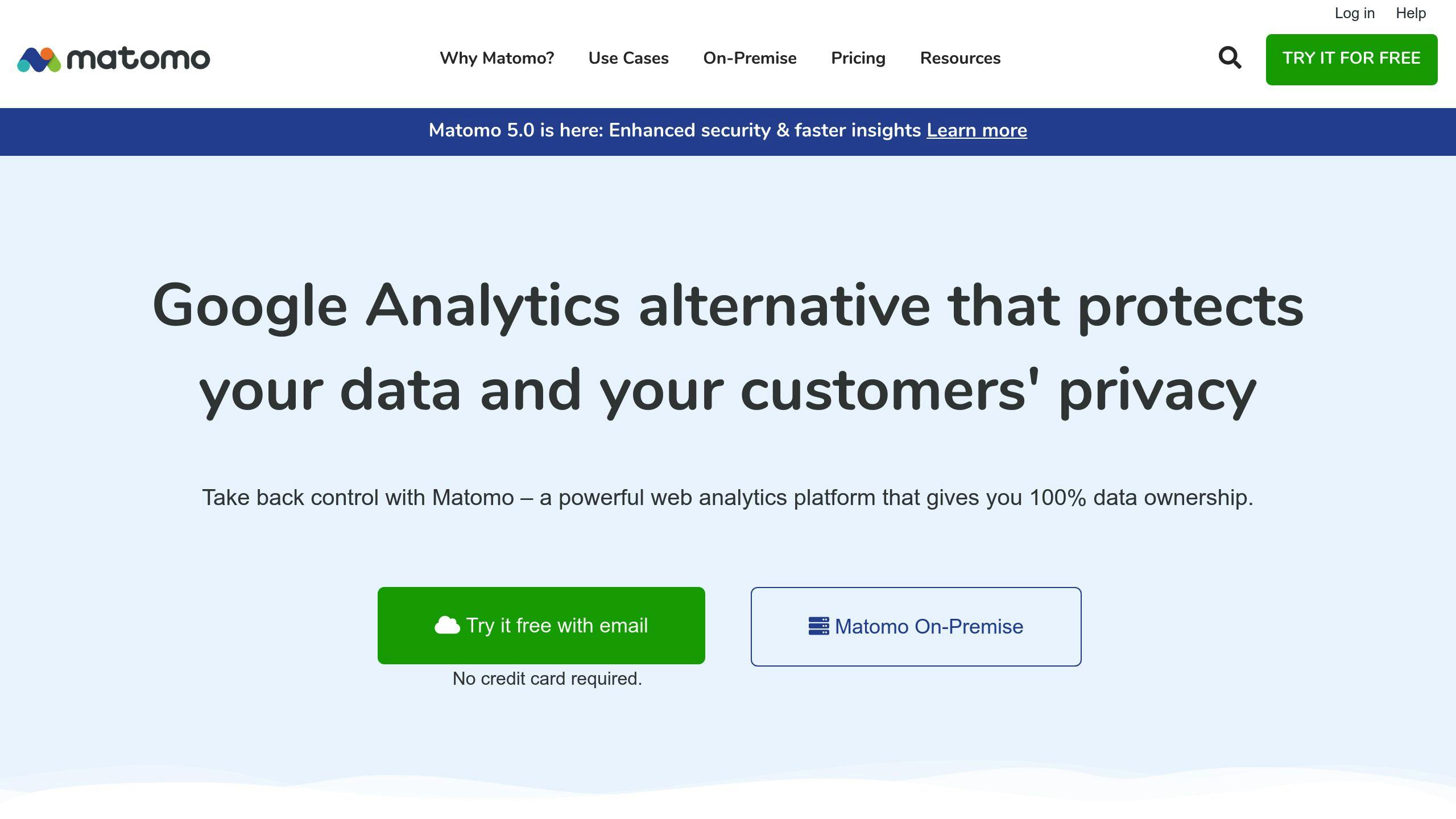
Matomo stands out as a privacy-driven alternative for marketers who want full control over their data. Unlike GA4, it’s an open-source platform that prioritizes keeping your data entirely in your hands.
With its self-hosted option, Matomo gives you complete ownership of your data, making it a go-to choice for organizations like the European Commission. This setup ensures compliance with strict privacy regulations, making it a great fit for industries like healthcare, finance, and those governed by GDPR.
Key privacy features of Matomo include:
- Automatic IP anonymization to protect user privacy
- Customizable data retention periods to meet your policies
- Granular data collection controls for tailored tracking
- Efficient cookie consent management for user transparency
- Comprehensive GDPR compliance tools
Matomo provides real-time insights into visitor behavior, conversions, and engagement. It integrates easily with major content management systems and e-commerce platforms. For instance, its WordPress plugin allows one-click installation for instant tracking, and its Shopify integration offers detailed analytics with privacy as a priority.
| Feature | What It Offers |
|---|---|
| Self-hosted Option | Full control and ownership of your data |
| Custom Data Retention | Flexible retention periods for your data |
| IP Anonymization | Better privacy protection for users |
| E-commerce Tracking | Detailed insights into online store activity |
| Real-time Analytics | Immediate data on visitor actions |
For those on a tight budget, Matomo’s free self-hosted version includes all the essential tools for thorough analytics. Its privacy-focused dashboards can be customized for various audiences, from executive summaries to in-depth technical reports, all while upholding strict privacy standards.
3. Looker Studio: Create Custom Dashboards

Looker Studio is a free tool that offers powerful features, but it does require some technical know-how to get the most out of it. It helps turn complex marketing data into clear, actionable visuals and connects seamlessly with tools like Google Analytics, Google Ads, and databases such as MySQL and PostgreSQL.
The platform allows you to bring data from multiple sources into one place, creating unified dashboards. This makes it easy to track performance across different marketing channels and understand how each one contributes to your goals.
Here are some standout features of Looker Studio:
| Feature | What It Does |
|---|---|
| Real-time Data Updates | Lets you monitor campaigns as they happen |
| Custom Data Connectors | Links to over 500 data sources |
| Automated Scheduling | Updates reports automatically, saving time |
| Interactive Filters | Lets stakeholders explore data dynamically |
| Collaborative Sharing | Gives team members access to shared insights |
One of Looker Studio's strengths is automating repetitive reporting tasks. By using automated dashboards, marketing teams can save 5–10 hours each week, avoiding the hassle of manual spreadsheet updates.
When building dashboards, focus on these key metrics to get the most value:
- Conversion tracking: Keep an eye on sales, leads, and goal completions.
- Channel performance: Compare traffic and engagement across various platforms.
- Campaign ROI: Measure the return on investment for each marketing effort.
Dashboards can be customized for different audiences. For instance, executives might prefer high-level KPIs, while managers may need detailed metrics for campaigns. Start with basic templates and expand as you get more comfortable. If your team already uses Google tools, Looker Studio is a natural fit.
While Looker Studio shines in data visualization, tools like Coupler.io specialize in automating data integration to make reporting workflows even smoother.
4. Coupler.io: Automate Data Integration
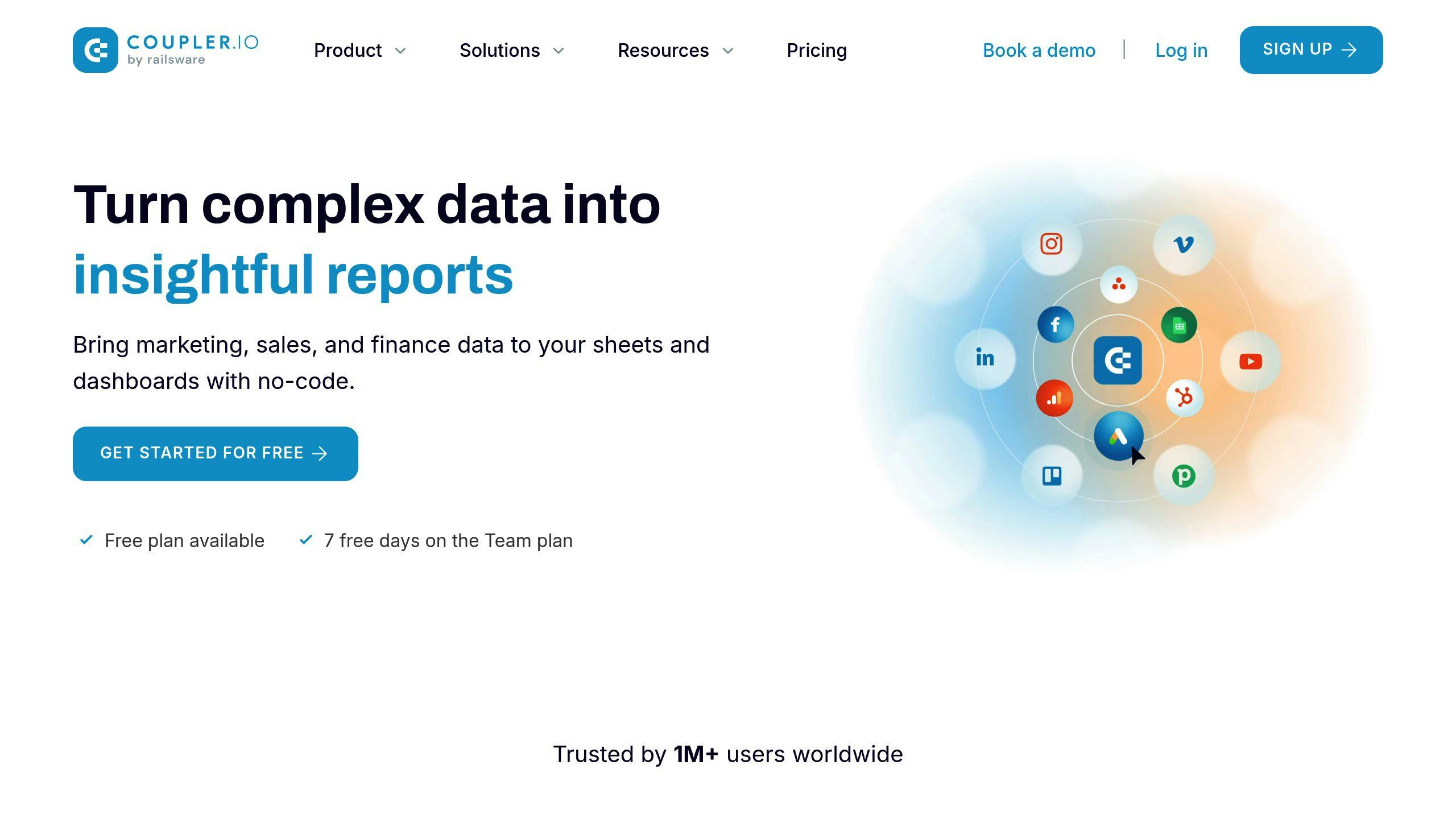
Coupler.io simplifies marketing analytics by automating data integration across platforms. With a free plan covering basic features, it removes the hassle of manual data collection by setting up automatic data flows that refresh on a schedule. This ensures your marketing tools stay connected effortlessly.
Here’s how Coupler.io handles different data sources:
| Data Source Type | What You Can Track |
|---|---|
| Social Media | Performance metrics from Facebook Ads |
| Website Analytics | User behavior data from Google Analytics 4 |
| Email Marketing | Campaign stats from Mailchimp |
| Custom Sources | Metrics from other marketing platforms |
By automating updates, marketing teams can save hours each week on preparing reports. Coupler.io also helps clean and standardize data automatically, so you can align formats - like dates - and merge metrics from various sources into cohesive performance indicators.
The platform focuses on connecting key tools, automating updates, and ensuring consistent metrics for smoother reporting. Coupler.io works well with visualization tools like Looker Studio, making it easy to create unified dashboards.
After integrating and organizing your data, you can use tools like Microsoft Clarity to dig deeper into user behavior, complementing Coupler.io's automation features.
5. Microsoft Clarity: Understand User Behavior
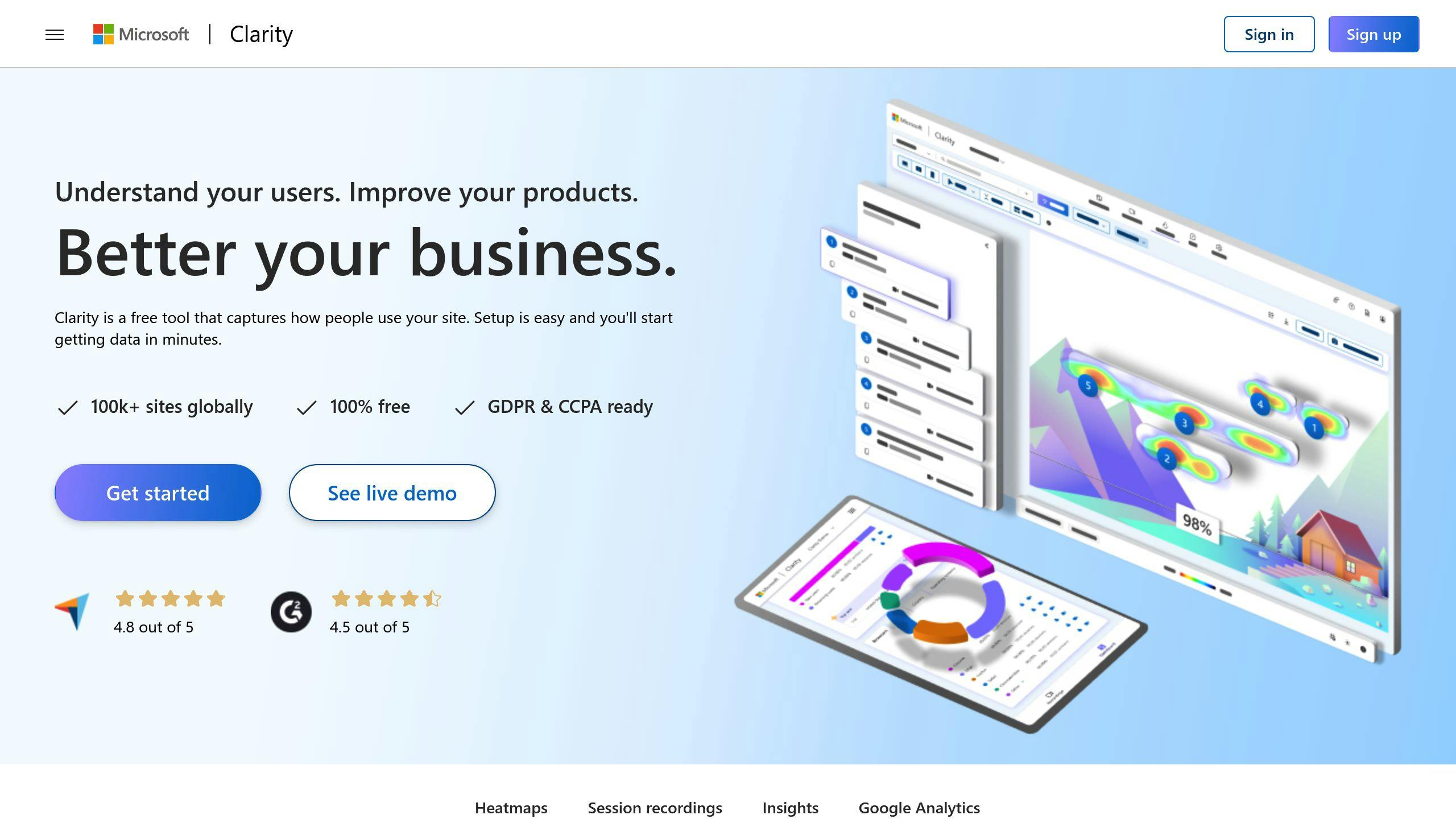
Microsoft Clarity is a free tool designed to help you see how users interact with your website. Unlike analytics tools that focus on raw numbers, Clarity offers visual insights like heatmaps and session recordings, giving you a clearer picture of visitor behavior.
The heatmap feature shows where visitors click, scroll, and hover. This can help you spot areas that grab attention or highlight problem spots. For instance, if users are clicking on parts of the page that aren't interactive, it might be time to rethink your design. Clarity also works alongside Google Analytics, so you can combine behavioral insights with your existing data.
| Feature | What It Reveals |
|---|---|
| Click Heatmaps | Most clicked areas and ignored sections |
| Scroll Maps | How far visitors scroll and where they stop |
| Session Recordings | Step-by-step playback of user navigation |
| Rage Clicks | Repeated clicks in frustration |
Session recordings are especially useful for uncovering issues in the user journey. These recordings let you watch how people move through your site, highlighting confusion or technical glitches. Clarity even flags sessions with rage clicks or excessive scrolling, so you can focus on areas that need improvement.
Privacy is a priority with Clarity. The tool automatically anonymizes sensitive data like passwords and credit card fields in session recordings, ensuring user data stays secure.
To make the most of Clarity, align your analysis with specific goals. For example, if you're tweaking a landing page, look at where users spend their time or which elements they interact with most. Use this data to refine layouts, buttons, or content.
The dashboard is easy to navigate, offering clear reports to help you track changes over time. This makes it simple to see how updates to your site affect user behavior. For deeper insights into search performance, pair Clarity with Google Search Console.
sbb-itb-5174ba0
6. Google Search Console: Monitor Search Performance
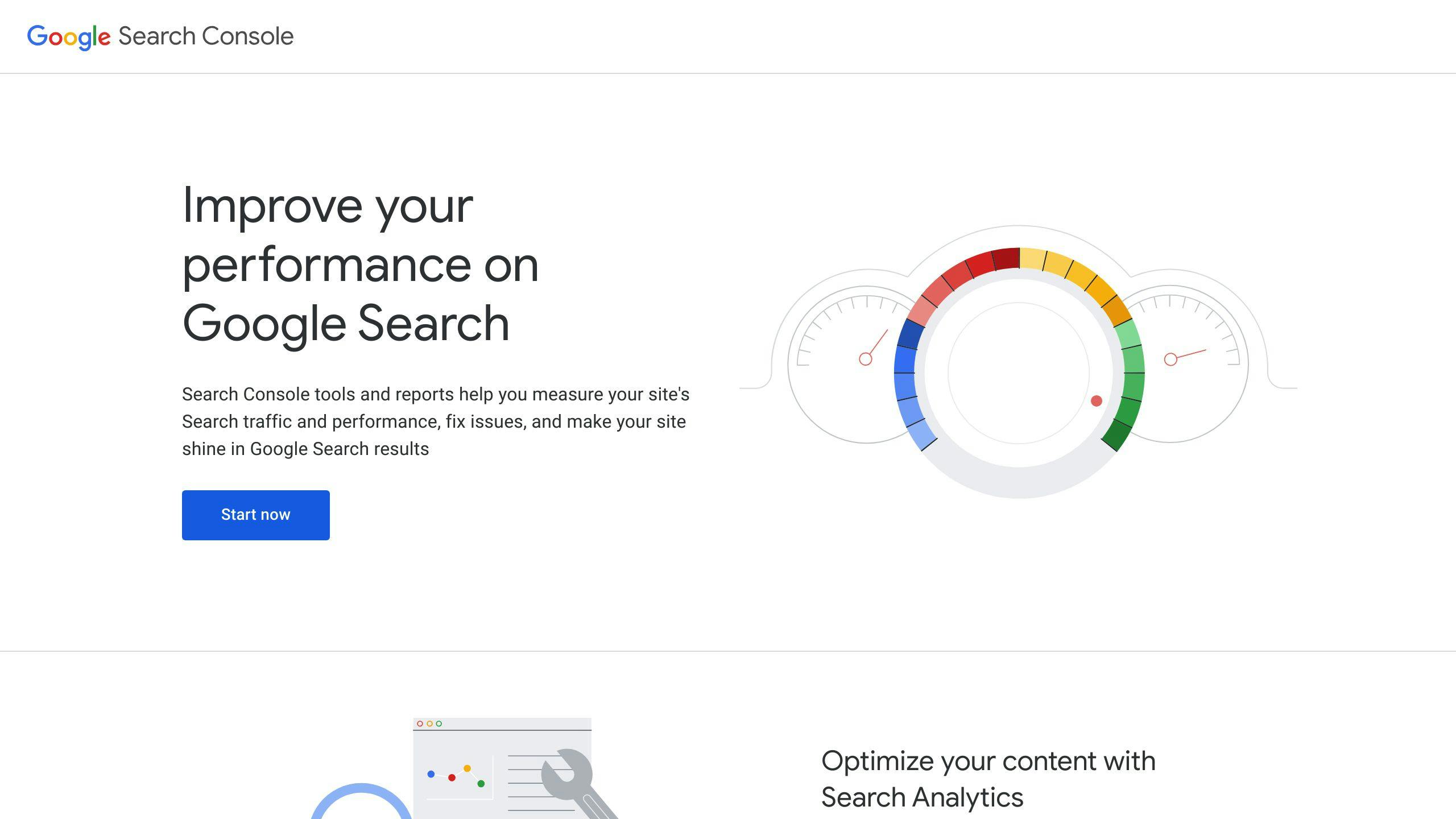
Google Search Console is a free tool that helps you understand how your site performs in Google's search results. While tools like Microsoft Clarity focus on user behavior, Search Console zeroes in on search visibility and technical issues.
The Performance Report provides key metrics like impressions, clicks, and keyword rankings. For instance, if you find a keyword ranking on page two (positions 11-20), you can optimize that content to push it to page one. By identifying top-performing keywords, you can craft content that targets those terms, improving both rankings and user engagement.
| Report Type | Insights Provided |
|---|---|
| Performance | Search queries, clicks, CTR, and ranking positions |
| Coverage | Indexed pages, crawl errors, and sitemap status |
| Enhancement | Mobile usability, Core Web Vitals, and structured data details |
The URL Inspection tool is perfect for diagnosing and fixing technical issues. If Google struggles to index your content, this feature pinpoints the problem - whether it's a blocked robots.txt file, missing meta tags, or mobile usability errors. After making corrections, you can request a recrawl to ensure the changes are reflected quickly.
When integrated with Google Analytics, Search Console becomes even more powerful. Analytics reveals what users do on your site, while Search Console tracks the journey from search query to site interaction, offering a complete picture.
The Coverage Report acts as a health check for your site. It highlights problems like duplicate content or broken links that could hurt your rankings. Plus, it sends email alerts whenever new issues arise, so you can address them promptly.
For local businesses, Search Console offers insights into geographic performance. You can filter data by country or region to understand where your content performs best, allowing you to refine your strategy for specific markets.
While Google Search Console focuses on search performance, tools like Mixpanel provide deeper insights into user engagement once visitors land on your site.
7. Mixpanel: Analyze User Engagement

Mixpanel is an analytics tool designed to help you dive deep into user behavior and engagement metrics. It's all about understanding how people interact with your product.
With Event Tracking, you can monitor specific actions like button clicks, feature usage, or conversion paths. One of Mixpanel's standout features is its ability to segment users based on behavior. This helps pinpoint which features drive engagement and which may need improvement. The real-time dashboard uses interactive visuals to highlight trends and patterns, making the data easier to interpret.
| Analysis Type | Insights You Get |
|---|---|
| Funnel Analysis | Understand user journeys and spot drop-offs |
| Retention Analysis | See how many users come back over time |
| User Segmentation | Group users by behavior and shared traits |
The funnel analysis tool is especially useful. For instance, you can track how users move from signing up to making a purchase, helping you identify where they drop off and how to improve the process. Even Mixpanel's free plan includes core features that work well for startups and small businesses.
Focus on tracking key events that align with your goals. This ensures you're gathering data that directly supports your business objectives.
If you're looking to combine Mixpanel's insights with data from other platforms, tools like Whatagraph make it easy to create unified reports across multiple channels.
8. Whatagraph: Simplify Reporting Across Platforms
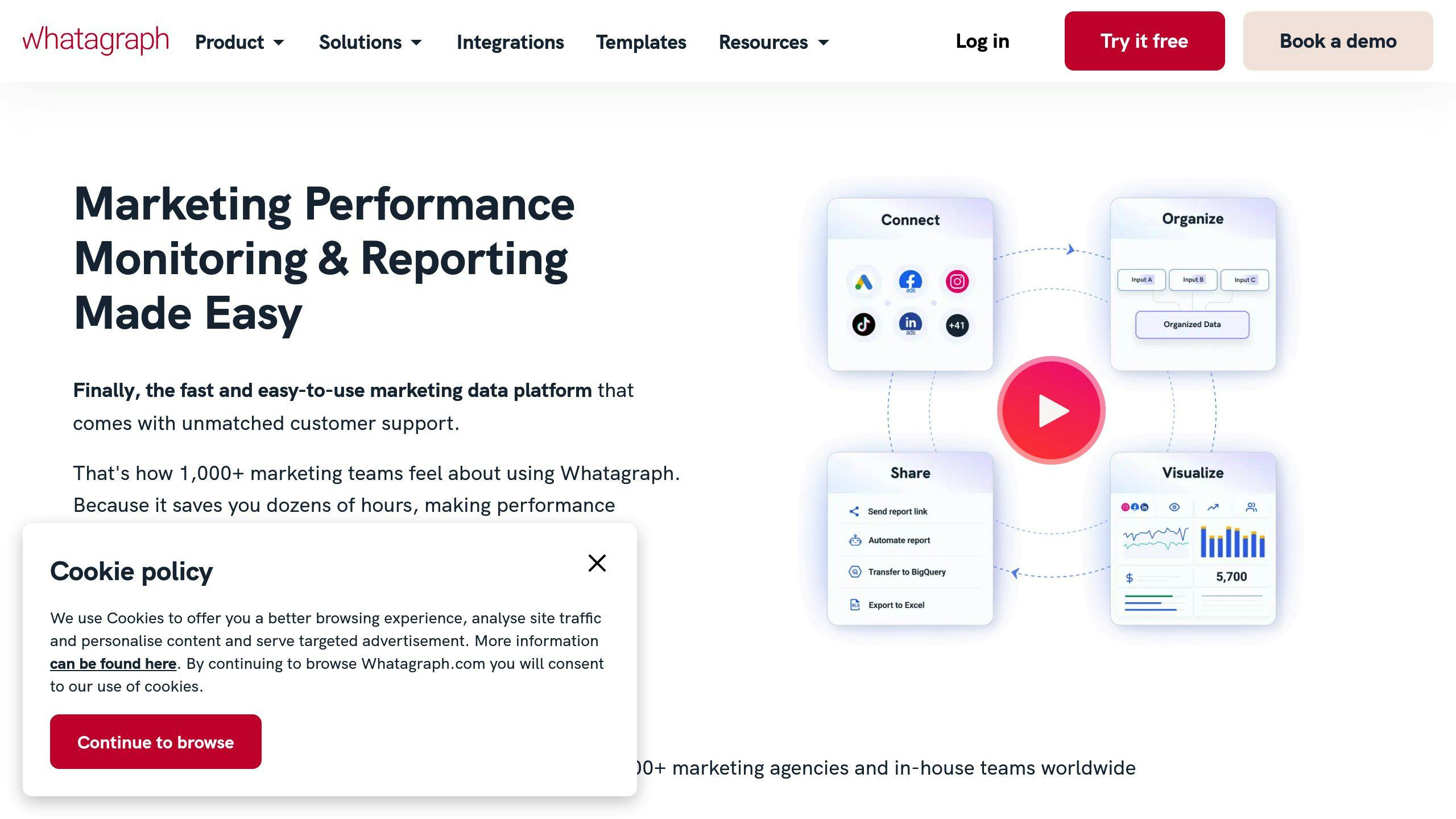
Whatagraph is a go-to tool for marketers looking to combine data from various marketing platforms into one clear, organized view. It connects with over 40 platforms, including heavyweights like Google Analytics, Facebook Ads, and LinkedIn Ads, making it a great option for managing marketing performance across multiple channels.
The platform makes it easy to bring together data from different sources into a single, user-friendly dashboard. For instance, a digital agency can merge data from Facebook Ads and Google Analytics into one report, simplifying client updates and internal reviews.
| Feature | What It Offers |
|---|---|
| Data Integration | Links with 40+ marketing tools |
| Automated Reports | Sends reports on a set schedule |
| Custom Templates | Pre-designed layouts for faster setup |
| Real-time Updates | Syncs live data seamlessly |
One of Whatagraph's standout features is its automation. You can set up reports to be sent automatically to your team or clients, cutting out manual work. This frees up time to focus on analyzing data and adjusting strategies.
The platform’s intuitive interface and ready-made templates make it easy to create tailored reports, even for those without technical expertise. It’s especially handy for tracking key metrics like website traffic, conversion rates, and social media engagement. The clean, visual presentation of these metrics makes it simple to spot trends and make informed decisions.
To get started, identify the metrics that matter most to your business goals. Begin with a small set of KPIs and expand as you get comfortable with the platform. You can try these features during the free trial before committing to a paid plan.
Once you’ve streamlined your reporting with Whatagraph, you can explore additional tools like Metrics Watch for even more automation, such as email-based updates.
9. Metrics Watch: Automated Email Reports
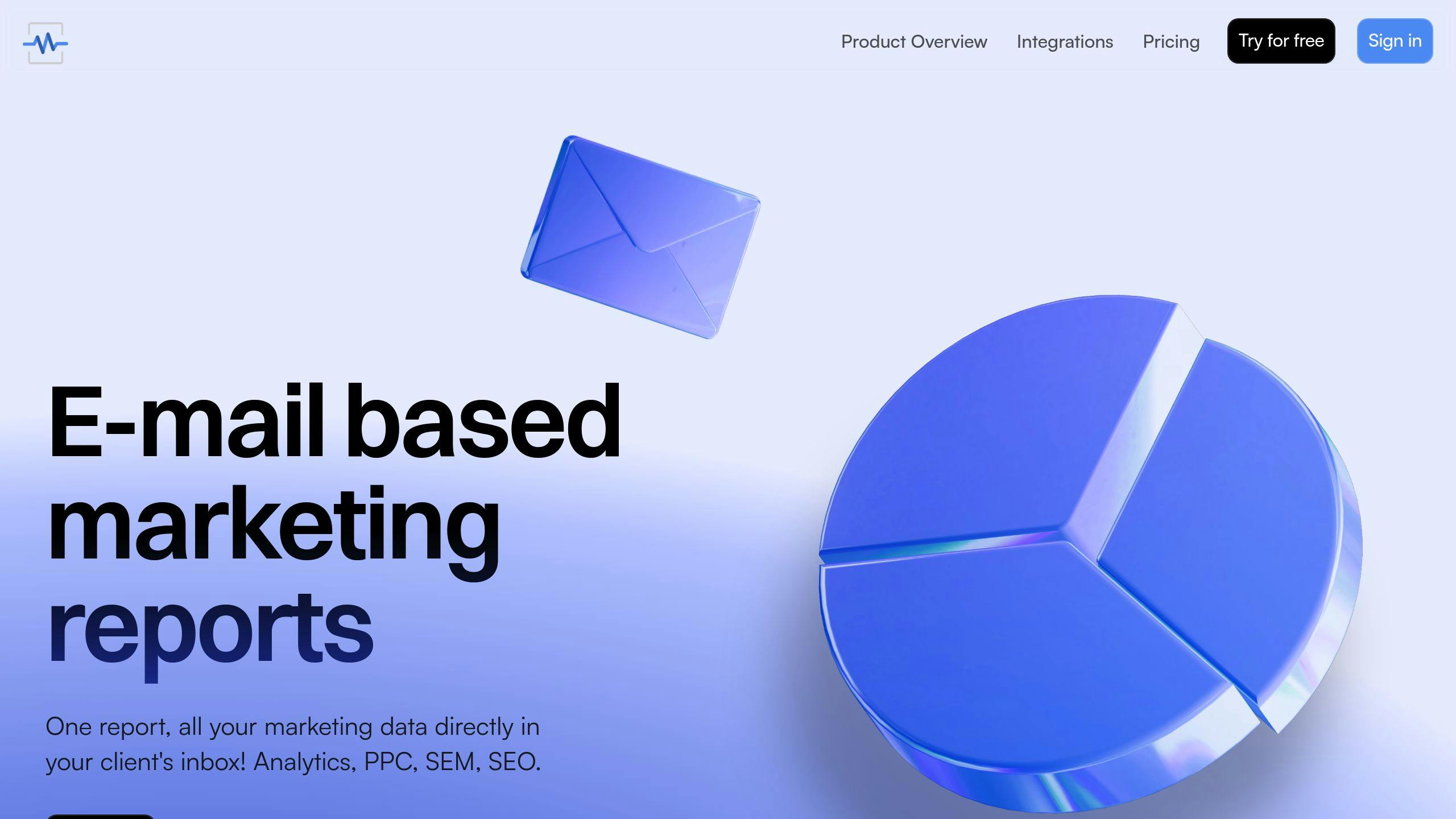
Metrics Watch simplifies marketing analytics by sending clear, actionable data straight to your inbox. Unlike tools that rely on dashboards, this platform focuses on email delivery, so you don’t have to navigate through multiple platforms.
Its filtering and prioritization features let you zero in on the metrics that matter most, avoiding unnecessary clutter for your team. Metrics Watch pulls data from various marketing channels, giving you a complete view of key metrics like website traffic, conversions, and engagement. For example, a small business can easily monitor weekly site traffic and ad performance - all without logging into multiple tools.
| Report Feature | Benefit |
|---|---|
| Direct Email Delivery | Skip logging into extra platforms |
| Custom Report Scheduling | Get updates exactly when you need them |
| Multi-source Integration | See all your marketing data in one place |
| Data Filtering | Focus only on the metrics that matter |
Getting started is straightforward: connect your data sources, pick the metrics you want to track, and set up a schedule for updates. You can tweak the report contents and frequency anytime to match your changing needs. A good tip? Begin with a few core metrics and expand as your priorities shift.
This email-based reporting is especially useful for teams that need frequent updates but don’t want the hassle of juggling multiple dashboards. By delivering insights directly to inboxes, Metrics Watch ensures everyone stays on top of performance.
And while Metrics Watch keeps you informed, tools like Ahrefs Free Tools can help you refine your SEO approach for better online visibility.
10. Ahrefs Free Tools: Boost Your SEO Efforts

Ahrefs, a popular SEO toolset, provides several free tools designed to help marketers sharpen their SEO strategies. The Ahrefs Webmaster Tools suite includes features for keyword research, backlink analysis, and SEO audits. Plus, the data refreshes every 24 hours, so you're always working with up-to-date information.
The Keyword Explorer is perfect for finding keywords that can drive more traffic to your site. It focuses on terms with high search volume and lower competition, making it easier to optimize your content. Meanwhile, the Backlink Checker lets you track up to 100 backlinks per domain, helping you analyze your link profile and uncover link-building opportunities.
| Feature | What It Does |
|---|---|
| Backlink Checker | Track up to 100 backlinks per domain |
| Keyword Explorer | Find keywords with search volume and difficulty scores |
| Site Audit | Detect and fix technical SEO issues |
| Rank Tracker | Monitor shifts in keyword rankings |
The Site Audit tool is handy for spotting and fixing technical SEO problems, which can improve your site's overall performance. Ahrefs also integrates well with tools like Google Analytics, making it easier to analyze SEO data and generate detailed reports.
Though the free version has fewer features than the paid plans, it provides essential tools that are especially useful for small businesses. Combined with other analytics platforms, Ahrefs' free tools can help you improve your search rankings and build a stronger marketing strategy.
Wrapping Up
Marketing analytics has come a long way, making it easier for businesses of all sizes to make data-driven decisions without overspending. By combining tools like Google Analytics 4 for website insights, Matomo for privacy-conscious tracking, and specialized options like Microsoft Clarity for user behavior analysis, you can build a strong analytics stack on a budget.
The key is choosing tools that match your specific goals. For example, if boosting search performance is your main focus, pairing Google Search Console with Ahrefs Free Tools is a great starting point. On the other hand, if automated reporting is your priority, tools like Whatagraph or Metrics Watch can simplify your workflow.
Here’s a quick guide to help you get started:
| Focus Area | Recommended Tools | Key Benefits |
|---|---|---|
| Website Analytics | GA4, Matomo | Understand user behavior, track conversions |
| Data Visualization | Looker Studio, Coupler.io | Build custom dashboards, automate data integration |
| Performance Tracking | Search Console, Mixpanel | Gain search insights, measure user engagement |
| Reporting | Whatagraph, Metrics Watch | Automate reporting, track cross-platform analytics |
To make the most of these tools, start by identifying your biggest challenges. Choose solutions that address those pain points first, then expand your toolkit as your needs grow. Regularly check for updates and new features to stay ahead and get the most out of your tools.


